Magnificent and distasteful, Russian palaces possess a unique allure. Their opulence, grandeur, and extravagance are awe-inspiring, but they also serve as a somber reminder of the cruel serfdom that plagued society for centuries.
It’s important to note that these grand homes couldn’t be maintained by a single owner alone. They required an army of virtual slaves who toiled tirelessly day and night, sacrificing their lives to ensure one family’s luxurious lifestyle. The Russian Wooden Palace, pictured above and below, is personally my favorite among the Russian palaces. Its design, craftsmanship, and sheer scale are unparalleled.
While most palaces were constructed using brick and stone, the Wooden Palace stood out by defying the norm, yet it didn’t compromise on opulence and splendor. Although some Russian palaces possess unique features, many draw inspiration from the architectural styles prevalent in Europe. However, one notable distinction is the influence of Asian design in their architecture.
As you revel in the splendor captured in these photos, it’s essential to reflect upon the tremendous suffering endured by countless individuals who built and maintained these homes. It’s worth noting that Russian monarchs and nobility weren’t the sole perpetrators of oppressive systems; such systems prevailed throughout Europe and much of the world. Furthermore, although we may believe that we have progressed significantly since the era of serfdom, capitalism has ushered in its own brand of economic servitude.
1. Catherine Palace
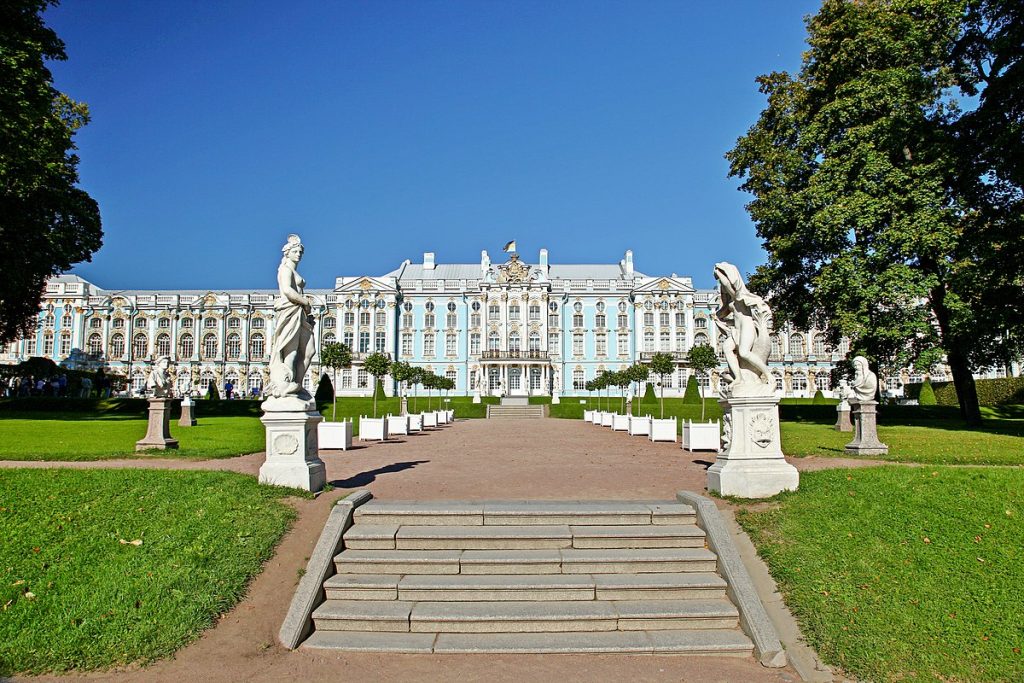
Gaze upon the Catherine Palace, an exquisite example of Rococo architecture. Situated in Tsarskoye Selo, St. Petersburg, Russia, this grand residence belonged to Queen Ekaterina. Originally built in 1717 by architect Johann-Friedrich Braunstein, it served as Catherine I of Russia’s summer palace.
Key details about the Catherine Palace:
Location: St. Petersburg, Russia
Construction Year: 1717
Builder: Catherine I of Russia
Architectural Style: Rococo architecture
Current Function: Museum
Current Owner: City of St. Petersburg
2. Petrovsky Palace

Commissioned by Catherine the Great, the Petrovsky Palace was designed by the renowned Russian architect Matvei Kazakov. Construction took place between 1775 and 1782. Initially, it served as a royal residence, but in 1918, it became the Zhukovsky Air Force Academy. After being closed for renovation in the late 20th century, Moscow Mayor Yuri Lushkov reopened it in 2009 as the House of Receptions for the Government of Moscow.
Key details about the Petrovsky Palace:
Location: Moscow, Russia
Construction Years: 1775-1782
Builder: Catherine the Great
Architectural Style: Russian Neoclassical style
Current Function: House of Receptions for the Government of Moscow
Current Owner: City of Moscow
3. Travel Palace
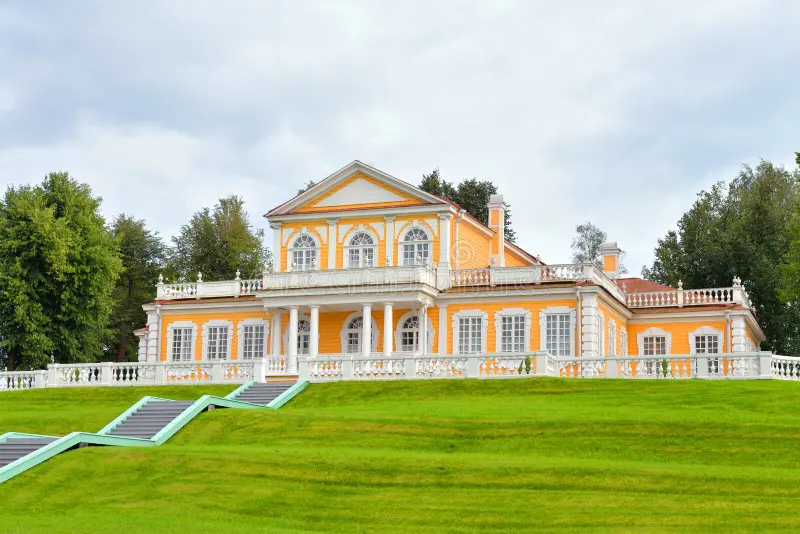
Constructed in the 18th century, the Travel Palace served as Emperor Peter the Great’s residence during his trips between St. Petersburg and Kronstadt. Located in St. Petersburg, this palace is now a museum maintained by the City of St. Petersburg.
Key details about the Travel Palace:
Location: St. Petersburg, Russia
Construction Year: 1707
Builder: Emperor Peter I
Architectural Style: –
Current Function: Museum
Current Owner: City of St. Petersburg
4. Priory Palace

The Priory Palace was initially built near St. Petersburg, overlooking the “Black Lake.” Originally intended for a twenty-year period, it ended up becoming the former residence of Russian emperors for several years. Constructed in 1799 based on the design by architect Nikolai Alexandrovich Lvov, it was initially meant for the prior of the Maltese Order. However, it was ultimately presented to the Order of St. John of Jerusalem by a decree from Paul I and never functioned as a priory.
Key details about the Priory Palace:
Location: St. Petersburg, Russia
Construction Century: 18th century
Builder: Emperor Peter I
Architectural Style: Pseudo-Gothic style
Current Function: Museum / Open to visitors
Current Owner: City of St. Petersburg
5. Predjama Castle
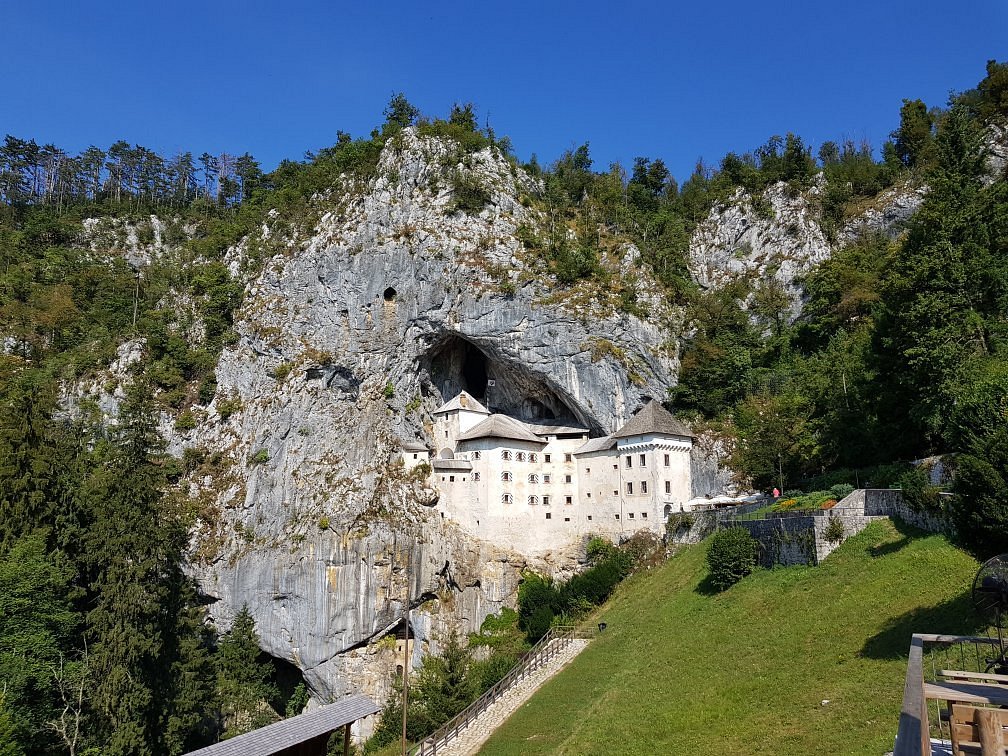
Perched within a cave mouth in south-central Slovenia, Predjama Castle is a Renaissance structure. Originally planned as a Gothic castle by the Patriarch of Aquileia, it gained fame as the residence of the knight Erasmus of Lueg, earning its name, Luegg Castle. After being besieged in the early 16th century, it passed through the hands of various families before being rebuilt in the Renaissance style.
Key details about Predjama Castle:
Location: Predjama, Slovenia
Construction Year: 13th century
Builder: Patriarch of Aquileia
Architectural Style: Gothic style / Renaissance style
Current Function: Museum
Current Owner: Yugoslav Communist authorities
6. Ostankino Palace

Formerly a summer residence and private opera theater of the Sheremetev family, Ostankino Palace graces Moscow. Nikolai Sheremetev built it and inaugurated the theater in the summer of 1795. However, after being summoned by Paul I to Saint Petersburg, Nikolai spent most of his time there. His wife, Praskovya Kovaleva-Zhemchugova, a former actress, assumed control of the theater. Eventually, the company disbanded. The Soviet government claimed the palace, transforming it into the National Museum of Serf Art.
Key details about Ostankino Palace:
Location: Moscow, Russia
Construction Century: 18th century
Builder: Nikolai Sheremetev
Architectural Style: Renaissance style
Current Function: National Museum of Serf Art
Current Owner: Soviet Government
7. Ramon Palace
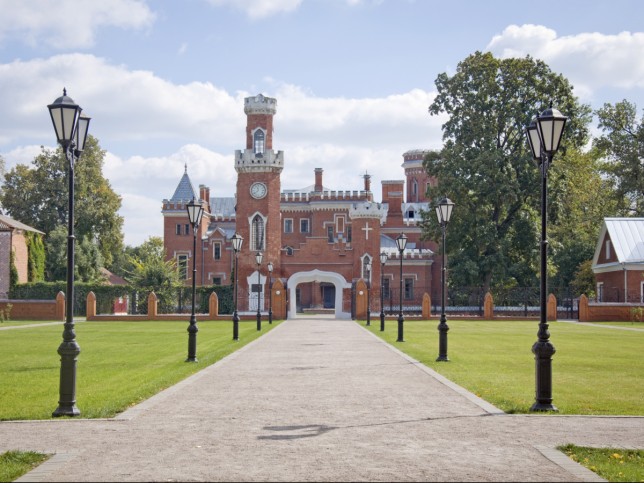
Also known as Princess Oldenburg’s Palace, Ramon Palace stands majestically in Ramon, Russia. This red-brick neo-Gothic building was constructed from 1883 to 1887 as the residence for Duke Alexander Petrovich of Oldenburg and his wife, Princess Eugenia Maximilianovna of Leuchtenberg. It was a wedding gift from Princess Eugenia’s uncle, Tsar Alexander II. The Oldenburg family had to abandon the palace due to the Russian revolution in the early 20th century. After a period of neglect, it underwent restoration and reopened in 2013.
Key details about Ramon Palace:
Location: Ramon, Russia
Construction Years: 1883-1887
Builders: Duke Alexander Petrovich of Oldenburg and his wife Princess Eugenia Maximilianovna of Leuchtenberg
Architectural Style: Neo-Gothic style
Current Function: Russian cultural landmark
Current Owner: Private owner
8. Mikhailovsky Palace
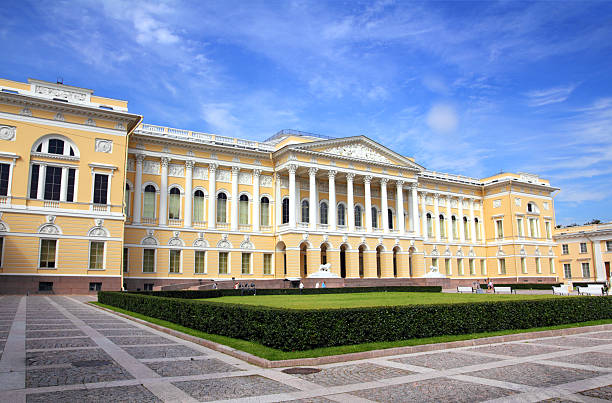
The Mikhailovsky Palace, situated in Saint Petersburg, Russia, exemplifies the grand ducal palaces of the Empire style neoclassicism. Originally intended as the residence of Grand Duke Michael Pavlovich, the youngest son of Emperor Paul I, construction began but was halted when Emperor Paul was overthrown and killed. It was later recommenced, following the design of Carlo Rossi, at the behest of Alexander I. The palace became a gift to Grand Duke Michael and his wife, Grand Duchess Elena Pavlovna, in 1825. Several modifications and improvements were made by the family during their residency in the palace. In 1894, the palace passed into the hands of the Dukes of Mecklenburg-Strelitz upon the death of Grand Duchess Catherine Mikhailovna, daughter of Grand Duke Michael. Fearing that the Romanov family might acquire the palace, Emperor Alexander III decided to repurchase it. Eventually, it became the Russian Museum.
Key details about Mikhailovsky Palace:
Location: Saint Petersburg, Russia
Construction Years: 1883-1887
Builder: Alexander I
Architectural Style: Empire style neoclassicism
Current Function: Russian Museum
Current Owner: City of Saint Petersburg
9. Swallow’s Nest

View from the top of Aurora Cape on the Neo-Gothic castle “Swallow’s Nest” (Russian: “Lastochkino Gnezdo”) under blue sky with fluffy white clouds in the background of the water of Black Sea and thew bay of Yalta city in Autumn season. The castle is one of the most popular visitor attractions in the Crimea, becoming the symbol of the Crimea’s southern coastline. It was constructed by design of the Russian architect Leonid Sherwood between 1911 and 1912 on money of Baron von Steingel.
Photo #068 taken on September 12, 2013
©2013 GuideToCrimea.Ru by Arthur Lookyanov
Perched in Crimea, Ukraine, the Swallow’s Nest is a decorative castle and a beloved tourist attraction. It replaced a small wooden cottage that belonged to a Russian general. The cottage later came into the possession of A. K. Tobin, a court doctor to the Russian Tsar. Baron von Stiengel acquired the cottage from Tobin and constructed the Neo-Gothic manor that still stands today. Poised atop the Aurora cliff, overlooking the sea near Gaspra, the Swallow’s Nest is renowned as one of the world’s most breathtaking castles and palaces.
Key details about the Swallow’s Nest:
Location: Crimea, Ukraine
Construction Century: 20th century
Builder: Baron von Stiengel
Architectural Style: Neo-Gothic style
Current Function: Tourist attraction
Current Owner: Republic of Crimea
10. Kadriorg Palace
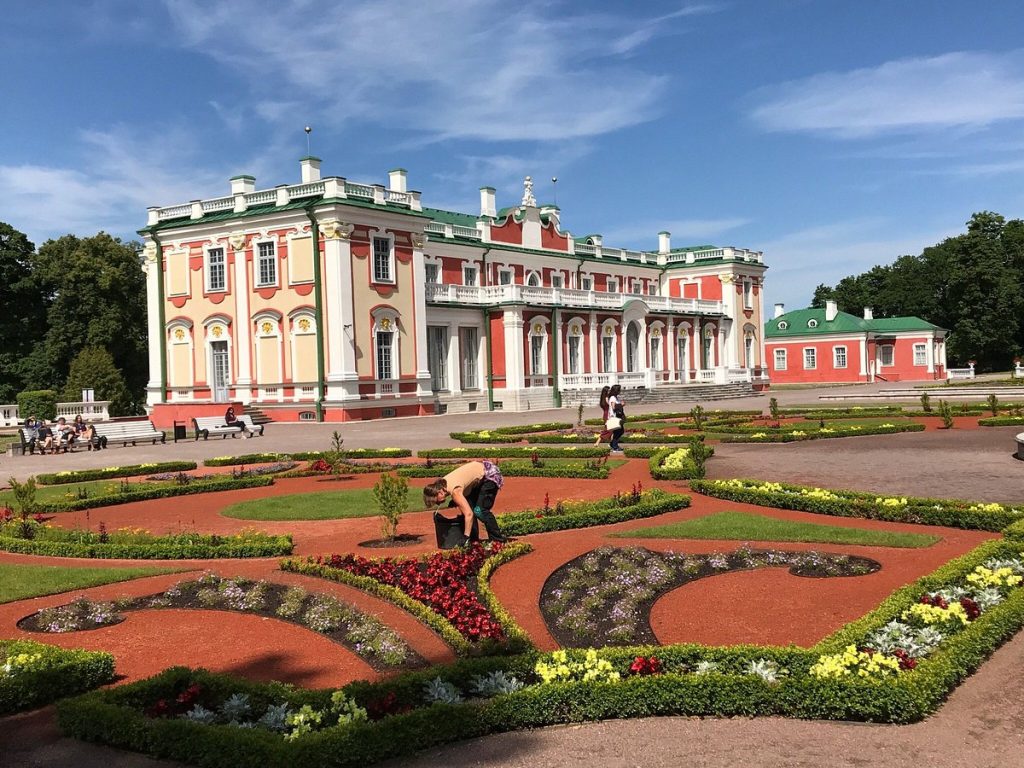
Built in Tallinn, Estonia, the Kadriorg Palace is a Petrine Baroque masterpiece. Peter the Great constructed it for Catherine I of Russia between 1718 and 1725. After Peter’s death, Catherine showed little interest in the property, but she sporadically visited the palace. Later, it served as the residence of the civilian governor of the Governorate of Estonia. When Estonia declared independence in 1919, Kadriorg Palace became state property. Today, it houses the Kadriorg Art Museum, a branch of the Art Museum of Estonia.
Key details about Kadriorg Palace:
Location: Tallinn, Estonia
Construction Years: 1718-1725
Builder: Peter the Great for Catherine I of Russia
Architectural Style: Petrine Baroque style
Current Function: Kadriorg Art Museum
Current Owner: Republic of Estonia
11. Gatchina Palace

The Great Gatchina Palace holds a special place among the residences of the Russian Imperial Family. Designed by Antonio Rinaldi for Count Grigori Grigoryevich Orlov, its construction took place between 1766 and 1781. This UNESCO World Heritage Site functions as a museum, with its park open to the public under the care of the Russian government.
Key details about Gatchina Palace:
Location: Gatchina, Russia
Construction Years: 1766-1781
Builder: Count Grigori Grigoryevich Orlov
Architectural Style: Russian classicism style
Current Function: UNESCO World Heritage Site / Museum
Current Owner: Russian Government
12. Konstantin Palace

Found in Saint Petersburg, the Konstantin Palace was established by Peter the Great in 1715. It stands as a former residence of the grand dukes of the House of Romanovs, showcasing the architectural style of 18th-century Russia. While it served as Russian President Vladimir Putin’s residence for a time, it will forever be known as the “Palace of Putin.”
Key details about Konstantin Palace:
Location: Saint Petersburg, Russia
Construction Year: 1715
Builder: Peter the Great
Architectural Style: Russian classicism style
Current Function: UNESCO World Heritage Site / Museum
Current Owner: Russian Government
13. Marienthal Palace

Originally known as Marienthal Palace and now called Castle BIP, this structure served as Emperor Paul’s bastion from 1795 to 1797. Designed by architect C. F. Brenna, it was registered as a fortress in the military records of the Russian Empire. From 1807 to 1810, the castle functioned as the first Russian School for the deaf. Neglected after World War II, the Russian government renovated it and transformed it into a 5-star hotel and restaurant.
Key details about Marienthal Palace:
Location: Saint Petersburg, Russia
Construction Years: 1795-1797
Builder: Emperor Paul
Architectural Style: –
Current Function: 5-star Hotel and Restaurant
Current Owner: Russian Government
14. Peterhof’s Grand Palace

Designed to be the centerpiece of Peter the Great’s “Russian Versailles,” the Peterhof’s Grand Palace showcases the brilliance of Jean-Baptiste Le Blond’s architectural vision. Built between 1714 and 1721 at Peter’s behest, this Baroque palace holds the distinction of being part of the UNESCO World Heritage Site.
Key details about Peterhof’s Grand Palace:
Location: Saint Petersburg, Russia
Construction Years: 1714-1721
Builder: Jean-Baptiste Le Blond
Architectural Style: Baroque architecture
Current Function: UNESCO World Heritage Site
Current Owner: Russian Government
15. Maryino Manor
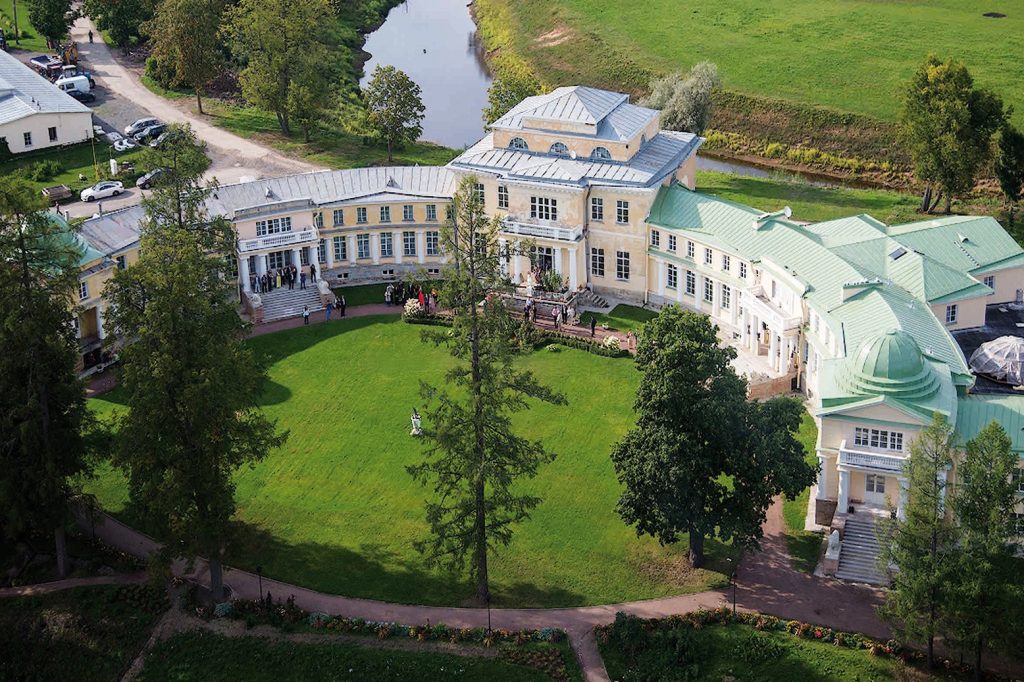
Architect K. Hoffman crafted the Maryino Manor between 1811 and 1820, resulting in one of the most remarkable national monuments of the 19th century. Once the manor of Prince Baryatinskih, it now serves as a luxurious spa hotel surrounded by a romantic park.
Key details about Maryino Manor:
Location: Saint Petersburg, Russia
Construction Years: 1811-1820
Builder: Architect K. Hoffman
Architectural Style: Baroque architecture
Current Function: Luxury spa hotel
Current Owner: Unclear
16. Vorontsov Palace
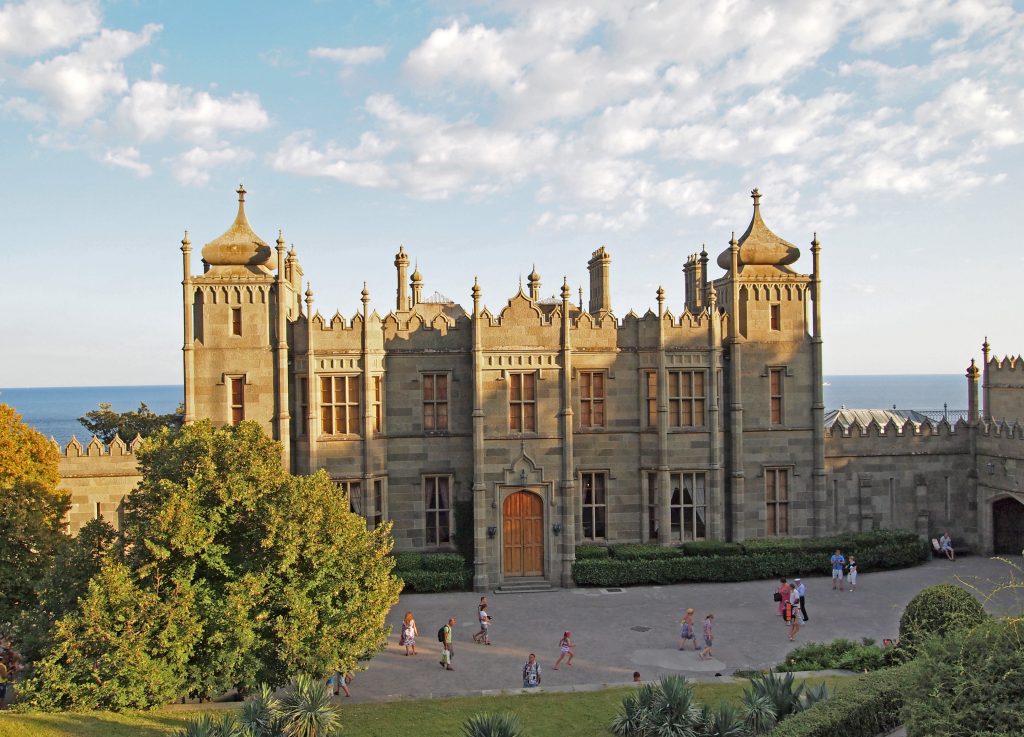
The Vorontsov Palace, also known as the Alupka Palace, was built from 1828 to 1848 for Russian Prince Mikhail Semyonovich Vorontsov. Designed by English architect Edward Blore and his assistant William Hunt in the Renaissance style, it stands as one of Crimea’s oldest and largest palaces. It has become a beloved tourist destination on Crimea’s southern coast.
Key details about Vorontsov Palace:
Location: Alupka, Crimea
Construction Years: 1828-1848
Builder: Russian Prince Mikhail Semyonovich Vorontsov
Architectural Style: Renaissance style
Current Function: Tourist attraction
Current Owner: Republic of Crimea
17. Massandra Palace

Constructed as the Châteauesque villa of Emperor Alexander III of Russia, the Massandra Palace stands as a testament to French architect Étienne Bouchard’s skill. It was built in the late 19th century in the Louis XIII style at the request of Semyon Mikhailovich Vorontsov, son of Mikhail Semyonovich Vorontsov. The palace passed into the hands of the Russian Imperial Domains Agency after Prince Semyon Mikhailovich Vorontsov’s death. Emperor Alexander III repurchased it to prevent the Romanov family from acquiring it. Today, it is open for guided tours under the care of the Republic of Crimea.
Key details about Massandra Palace:
Location: Massandra, Crimea
Construction Century: 19th century
Builder: Architect Étienne Bouchard
Architectural Style: Louis XIII style
Current Function: Tourist attraction
Current owner: Republic of Crimea
18. Winter Palace

Originally built in 1708 for Peter the Great and his family, the Winter Palace underwent several reconstructions before its final Baroque version was completed in 1735 by architect Bartolomeo Francesco Rastrelli during Empress Anna’s reign. The design impressed Grand Duchess Elizabeth, daughter of Peter the Great, who commissioned further improvements in the Elizabethan Baroque style. The Winter Palace, once the official residence of Russian Emperors, now forms part of the Hermitage art museum, accessible to the public.
Key details about the Winter Palace:
Location: Saint Petersburg, Russia
Construction Year: 1708
Builder: Peter the Great
Architectural Style: Baroque architecture / Elizabethan Baroque style
Current Function: Hermitage art museum / Open to the public
Current Owner: Russian Government
19. Yelagin Palace

Designed by architect Carlo Rossi for Alexander’s mother, Maria Fyodorovna, Yelagin Palace exemplifies Palladian-style architecture. Constructed during Catherine the Great’s rule, it served as a royal summer palace during the reign of Alexander I. After Maria Fyodorovna’s passing, the palace ceased to be the residence of the imperial family. It remained abandoned until Nicholas II leased it to his prime ministers. In the mid-20th century, Yelagin Palace underwent reconstruction and now functions as a museum.
Key details about Yelagin Palace:
Location: Saint Petersburg, Russia
Construction Year: 1822
Builder: Architect Carlo Rossi
Architectural Style: Palladian style
Current Function: Museum
Current Owner: Russian Government
20. Wooden Palace of Tsar Alexei Mikhailovich

The Wooden Palace of Tsar Alexei Mikhailovich was erected in 1667 without the use of nails or fastening materials. It consisted of two sections—the male part, housing ceremonial chambers and chambers for the Tsar and his sons, and the female part, designated for the Tsarina and the Tsar’s daughters. The palace was reconstructed after Alexei Mikhailovich’s death but gradually fell into disrepair during the 18th century. Empress Catherine the Great ordered its demolition, leaving only ruins behind. Centuries later, the Russian government initiated its reconstruction, transforming it into a museum.
Key details about the Wooden Palace of Tsar Alexei Mikhailovich:
Location: Moscow, Russia
Construction Year: 1667
Builder: Tsar Alexei Mikhailovich
Architectural Style: –
Current Function: Museum
Current Owner: Russian Government
21. Izmailovsky Kremlin
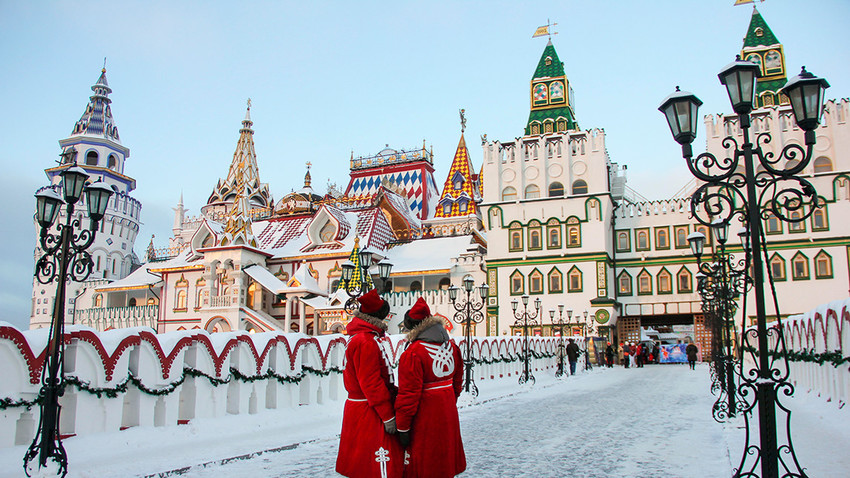
While the term “kremlin” typically refers to a fortress or citadel, the Izmailovsky Kremlin was not built for defense but as a cultural and entertainment complex. Completed in 2007, it features a replica of Tsar Alexei Mikhailovich’s wooden summer palace and other structures resembling 18th-century Russian architecture. The Izmailovsky Kremlin houses several museums open to the public.
Key details about Izmailovsky Kremlin:
Location: Moscow, Russia
Construction Year: 2007
Builder: Unclear
Architectural Style: –
Current Function: Museum
Current Owner: Russian Government
22. Tsaritsyno Palace

Located in the south of Moscow, Tsaritsyno Palace is a palace museum and park reserve founded in 1776 under Catherine the Great’s order. Designed by the renowned Russian architect Vasily Bazhenov, this Pseudo-Gothic summer residence for Catherine the Great was left unfinished and remained untouched for over 200 years after her death. Extensive reconstruction efforts between 2005 and 2007 finally completed the palace. It now houses a museum within the Tsaritsyno Museum Reserve.
Key details about Tsaritsyno Palace:
Location: Moscow, Russia
Construction Year: 1776
Builder: Catherine the Great
Architectural Style: Pseudo-Gothic style
Current Function: Museum
Current Owner: Tsaritsyno Museum Reserve
23. Moscow Kremlin
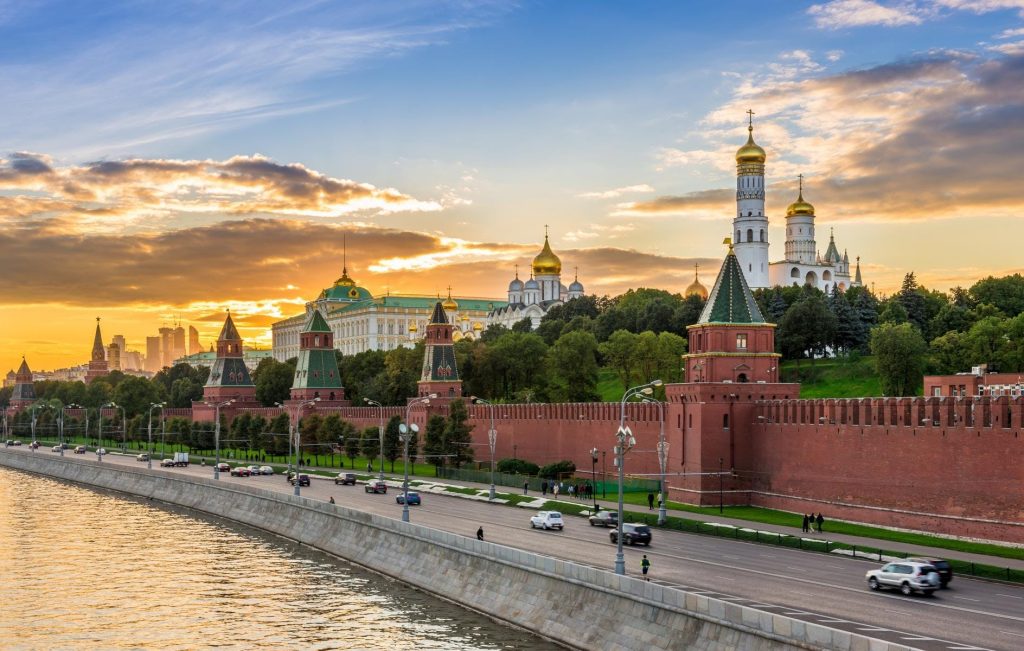
Originally built in 1156, the Moscow Kremlin’s original structure no longer exists. The oldest surviving building within the Kremlin dates back to the 14th century and was reconstructed with red bricks by Italian architects in the following century. It has undergone numerous remodelings, incorporating Byzantine, Russian Baroque, and classical styles. During the Soviet era, the Moscow Kremlin served as the headquarters of Vladimir Lenin and the Soviet government. After the collapse of the Soviet Union in 1991, it became the executive headquarters of the Russian Federation. The Kremlin is part of the UNESCO World Heritage Site.
Key details about the Moscow Kremlin:
Location: Moscow, Russia
Construction Year: 14th century
Builder: Unknown
Architectural Styles: Byzantine style / Russian Baroque architecture / Russian classicism style
Current Function: UNESCO World Heritage Site / Executive headquarters of the Russian Federation
Current Owner: Russian Government
24. Smolny Palace
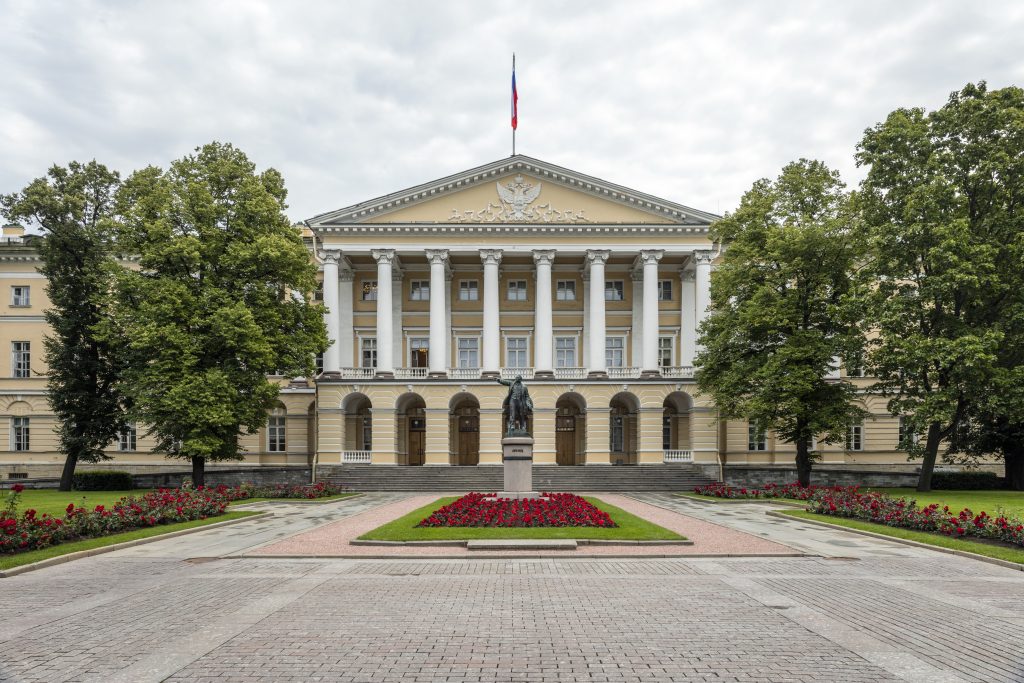
The Smolny Palace was originally built in 1708 for Peter the Great and his family, undergoing multiple reconstructions until its completion in 1735 by architect Bartolomeo Francesco Rastrelli during Empress Anna’s reign. It captivated Grand Duchess Elizabeth, daughter of Peter the Great, who commissioned further modifications in the Elizabethan Baroque style. Formerly an official residence of Russian Emperors, it is now part of the Hermitage art museum, accessible to the public.
Key details about Smolny Palace:
Location: Saint Petersburg, Russia
Construction Year: 1708
Builder: Peter the Great
Architectural Style: Baroque architecture / Elizabethan Baroque style
Current Function: Hermitage art museum / Open to the public
Current Owner: Russian Government
25. Sevastyanov’s House
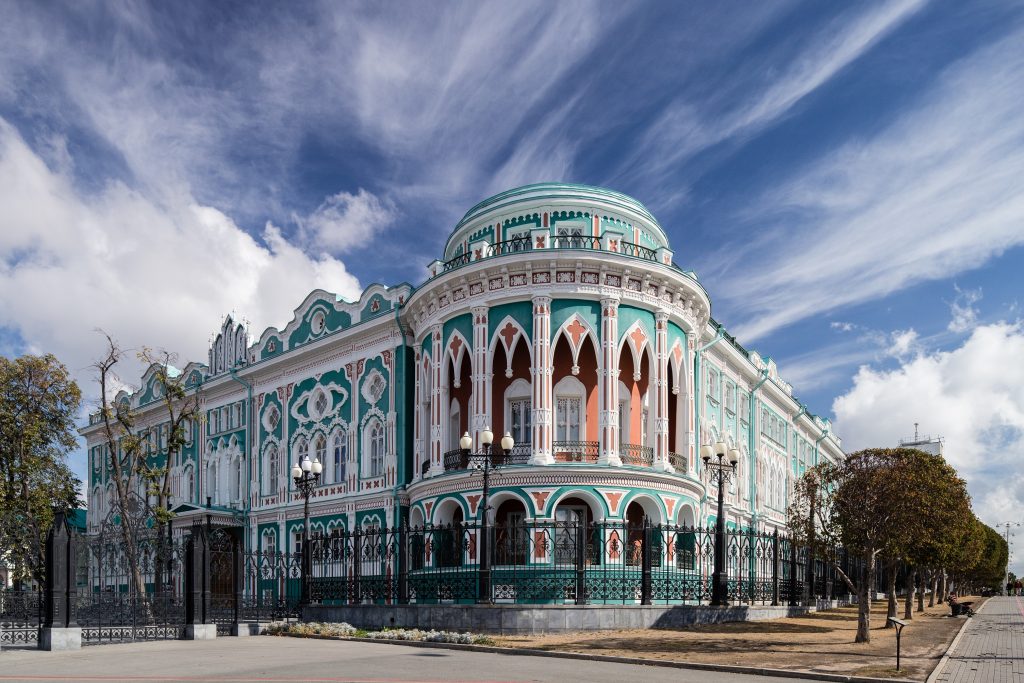
Initially built in 1817, Sevastyanov’s House underwent significant extension and decoration when acquired by successful businessman Nikolay Sevastyanov. The architect A. I. Paduchev combined Moorish and Gothic styles to create the stunning Sevastyanov’s House. Sevastyanov owned the house until 1880 when he was promoted and had to relocate to Saint Petersburg. He sold the house to the treasury, and it subsequently changed hands multiple times. In 2008, it briefly served as the residence of the President of the Russian Federation in Yekaterinburg, but its current purpose and owner remain unclear.
Key details about Sevastyanov’s House:
Location: Yekaterinburg, Russia
Construction Year: 19th century
Builder: Nikolay Sevastyanov
Architectural Style: Gothic style / Moorish architecture
Current Function: Unclear
Current Owner: Russian Government
26. Stroganov Palace
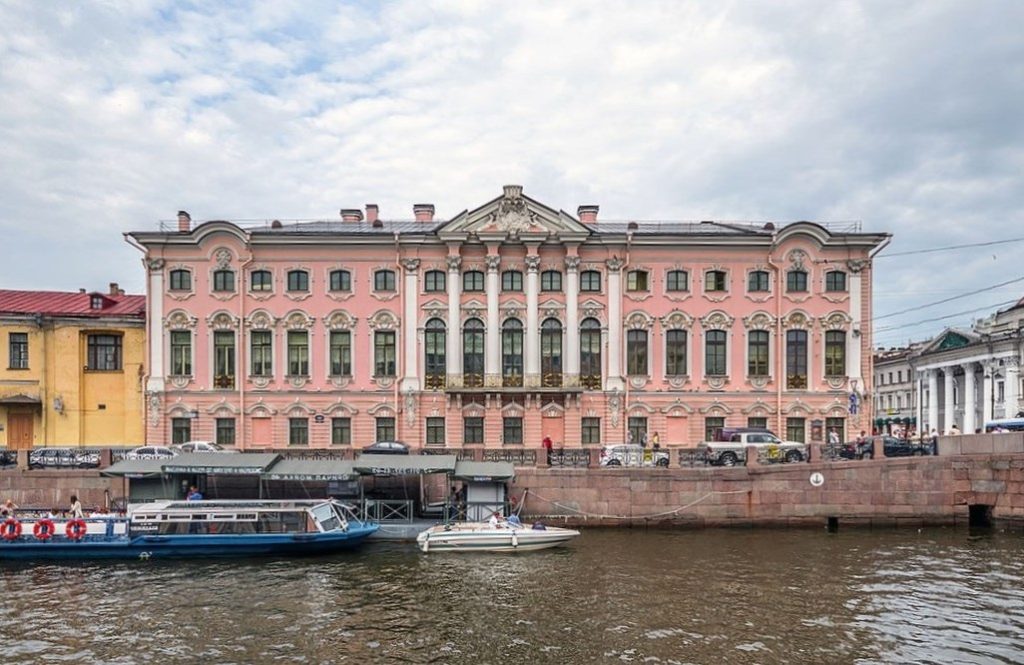
The Stroganov Palace, located in the heart of Saint Petersburg, was commissioned by Count Sergei Stroganov and designed by renowned Italian architect Bartolomeo Rastrelli. Construction began in 1752 and was completed in 1754. The palace showcases exquisite Rococo-style architecture and served as the residence of the Stroganov family until the Russian Revolution. It now houses the Russian Museum’s collections of applied and decorative arts.
Key details about the Stroganov Palace:
Location: Saint Petersburg, Russia
Construction Years: 1752-1754
Builder: Count Sergei Stroganov
Architectural Style: Rococo architecture
Current Function: Russian Museum (collections of applied and decorative arts)
Current Owner: City of Saint Petersburg
27. Yusupov Palace
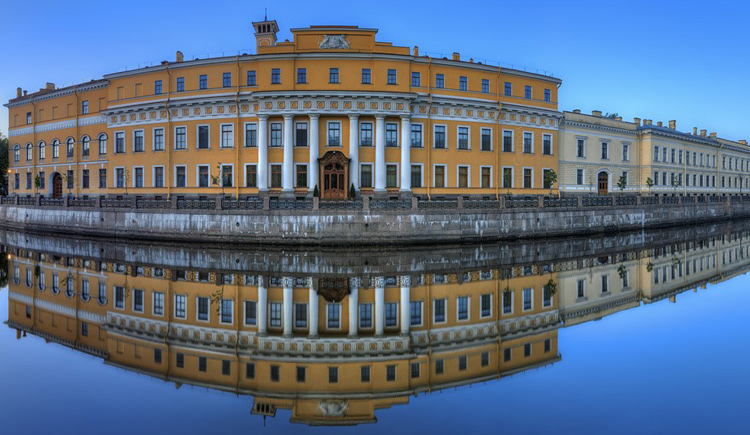
The Yusupov Palace, situated in Saint Petersburg, is known for its historical significance and stunning interiors. Originally built in the 1770s, it was acquired by the Yusupov family in 1830. The palace underwent extensive renovations and became the luxurious residence of the Yusupovs, one of the wealthiest families in Russia. The palace is infamous for being the site of the murder of Grigory Rasputin, a mystic and advisor to the Romanovs, in 1916. Today, it serves as a museum and is open to the public.
Key details about Yusupov Palace:
Location: Saint Petersburg, Russia
Construction Years: 1770s
Builder: Unknown
Architectural Style: Various styles, including Neoclassical and Rococo
Current Function: Museum
Current Owner: Russian Government
28. Catherine Palace

The Catherine Palace, located in the town of Pushkin (formerly Tsarskoye Selo), near Saint Petersburg, is a magnificent Baroque-style palace that was commissioned by Empress Elizabeth and completed in 1756. It was named in honor of Catherine I, the mother of Empress Elizabeth and wife of Peter the Great. The palace is famous for its opulent interiors, including the iconic Amber Room. Severely damaged during World War II, the Catherine Palace has been meticulously restored and is now a major tourist attraction.
Key details about Catherine Palace:
Location: Pushkin, Russia
Construction Year: 1756
Builder: Empress Elizabeth
Architectural Style: Baroque architecture
Current Function: Museum / Tourist attraction
Current Owner: Russian Government
29. Livadia Palace

The Livadia Palace, situated in Crimea, Ukraine, was built for Russian Emperor Nicholas II and his family. Construction began in 1910 and was completed in 1911. The palace served as a summer residence and witnessed important historical events, including the Yalta Conference in 1945, where Winston Churchill, Franklin D. Roosevelt, and Joseph Stalin met to discuss post-World War II Europe. The palace is currently a museum and is open to visitors.
Key details about Livadia Palace:
Location: Yalta, Crimea, Ukraine
Construction Years: 1910-1911
Builder: Russian Emperor Nicholas II
Architectural Style: Neo-Renaissance style
Current Function: Museum
Current Owner: Ukrainian Government
30. Peter and Paul Fortress

The Peter and Paul Fortress, founded by Peter the Great in 1703, is the oldest structure in Saint Petersburg. Initially built as a defensive fortification, it later served as a political prison and is now a historical and cultural complex. The fortress is home to the Peter and Paul Cathedral, where many Russian tsars and tsarinas are buried, including Peter the Great himself. It also houses several museums and exhibitions.
Key details about the Peter and Paul Fortress:
Location: Saint Petersburg, Russia
Construction Year: 1703
Builder: Peter the Great
Architectural Style: Fortress architecture
Current Function: Historical and cultural complex
Current Owner: Russian Government
These are just a few examples of the many remarkable palaces and castles in Russia and neighboring countries. Each one represents a unique blend of history, architecture, and cultural heritage, attracting visitors from around the world to marvel at their grandeur.
